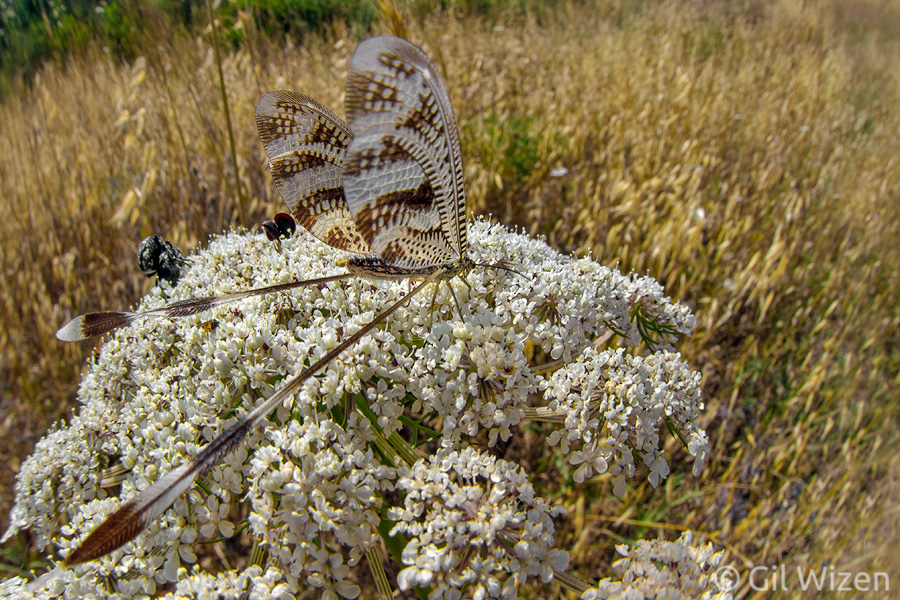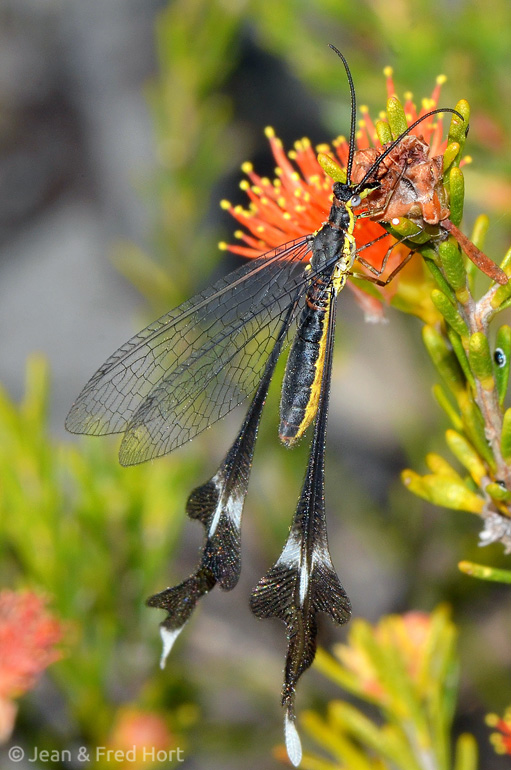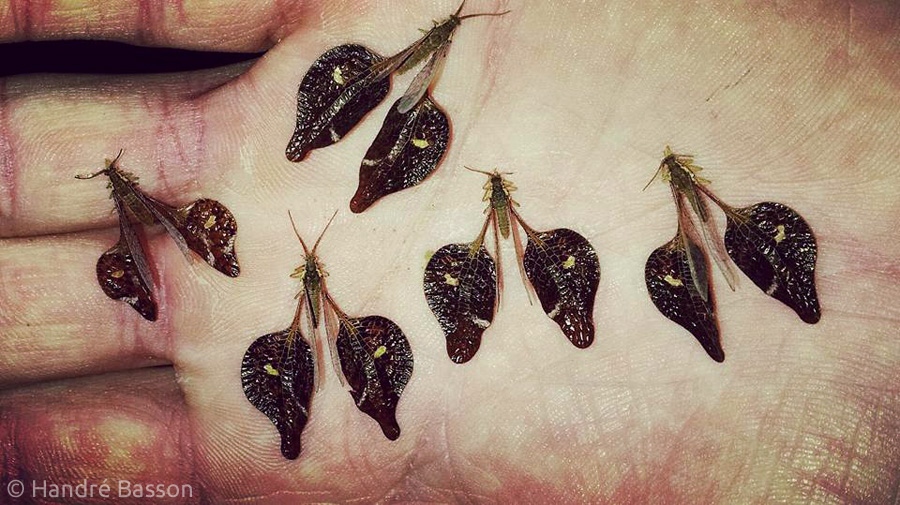Spoonwings
Last week I posted about Dielocroce hebraea, a species of threadwing antlion found in Israel. The article got a huge positive response and I am more than grateful for that, but I wouldn’t do these mystical insects justice without mentioning the second subfamily of Nemopteridae – the spoonwings (Nemopterinae).
Spoonwings share a close resemblance to threadwing antlions in appearance. They too have extremely long hindwings, but in their case the base of wings is narrow and as these extend further away from the insect’s body they become wider, sometimes bearing several lobes marked in black and white. Some species (members of genus Nemoptera) have similarly decorated forewings, and overall the wings are somewhat iridescent.
Contrary to the cryptic threadwing antlions, the spoonwing adults occur in open sunny places, such as grasslands and meadows. These are showy insects that fly by day, visiting flowers in search for their food – nectar and pollen. They are very fond of Apiaceae flowers, and occasionally several adults can be seen crowding and feeding on the same inflorescence. When they do take off they fly clumsily, slowly bouncing up and down in the air. It is quite difficult to tell which insect they are while in mid-air, but once they land it becomes very clear.

Spoonwing (Nemoptera aegyptiaca) feeding on wild carrot inflorescence, frontal view. Carmel Mountain Range, Israel
Surprisingly, larvae of Nemopterinae are poorly known. Sightings of live larvae are unheard of and most likely there are zero photographs of them out there. We know close to nothing about the life history of these majestic insects. Their eggs are laid on the ground surface, and the hatching larvae quickly burrow into the soil. Unlike the giraffe-larvae of threadwing antlions, they are robust and do not have a long neck. There are several speculations as to where they continue their development and what they feed on. In a paper published in 1995, Monserrat and Martinez described how ants harvest the eggs and young larvae, suggesting that the larvae are myrmecophilous (associated with and living inside ant nests). A few years later Popov (2002) showed that the larvae reject a large variety of arthropod prey, supporting the hypothesis that they are specialists in their diet.
Israel is home to three beautiful species of spoonwings. The most common one is Nemoptera aegyptiaca, which can be observed in activity in late spring. Like most species in the genus Nemoptera, adults can be easily recognized by their decorated forewings. It is hard to describe what it is like seeing them in real life. Cute. I think this is the right word.
Something interesting I noticed about adult spoonwings is that the hindwings are sometimes twisted like corkscrews. I believe this is an artifact caused when they are spreading the wings after emergence from the cocoon. It gives these insects character.

Spoonwing (Nemoptera aegyptiaca) feeding on wild carrot inflorescence. Carmel Mountain Range, Israel
For years I accepted the fact that I may never get to see the other spoonwing species in Israel. I just believed that a lot of luck is involved in finding them, something like being in the right place at the right time. And this is partially true, as I learned a couple of years ago. I visited a site in the Golan Heights (northern Israel), looking for predatory katydids. I arrived very early in the morning, because it is easier to photograph insects during these hours. As the sun came up across the pink sky, I suddenly realized that I am witnessing a mass emergence event of spoonwings. However they were not N. aegyptiaca but Lertha palmonii, a much more delicate and obscure species. Adults were climbing on the dry grasses in dozens, some of them were still in the process of spreading their curled wings. Within minutes they took to the air, flapping their tiny wings and bouncing around me like small birds of paradise. It truly was a magical moment.
The third Israeli species, which goes by the poetic name of Halter halteratus, seems to be very rare in Israel and more common in North Africa. In fact, the majority of spoonwing species occur in Africa, where some impressively large species can be found.
Still not impressed? Check out this Australian species, Chasmoptera huttii, which I nickname “the dragon spoonwing”. If you do not think this insect looks amazing then I have absolutely no idea what you are doing on this website…
This photo gives a nice sense of scale:
You can see more nice photos of this species here, here and here. These photographs were taken by Jean and Fred Hort in Western Australia, who were kind enough to let me post them here. Their gallery is an impressive collection of flora and fauna from that region, and they have a very keen eye for unique arthropods. I found myself drooling over their beautiful photographs and strongly recommend checking out their flickr photostream.
UPDATE (10 Dec, 2015): Handré Basson photographed another amazing species of spoonwing in South Africa – Palmipenna aeoleoptera. He is a naturalist with a very good eye for finding interesting arthropods, and he shares his beautiful photographs on his Facebook page. I thank him for giving me permission to show his photos.
UPDATE (2 May, 2018): Torsten Dikow brought to my attention that the unique hindwings might have a role in avoiding predators. A study conducted on the species above (Palmipenna aeoleoptera) showed that intact hindwings deterred attacks from small robber fly species, possibly by making the spoonwing appear larger.













Henry Robison
Gil:
These are stunning photos! What camera gear did you use to shoot? Flash? Have you done any articles on your wonderful technique?
wizentrop
Thank you Henry! The photos featured in this post were taken by three different cameras I owned over the years (and I believe the number even goes up to five if you include the ones from Australia – not taken by me) using various settings, so it is difficult to give a general recipe. I might write one or two posts in the future about some special techniques that I use.
Invertebratedude
These are very beautiful, more so than the prettiest butterflies in my opinion! The Nemopteridae sure hold some of the jewels of the insect world!
Sean McCann
HOLY MOLY!!! What a fabulous animal!
Bob Parks
Excellent article and pictures. Very well done.
Thanks
Ariel Qassis
משובח, חבל שאין זחלים.
wizentrop
תודה רבה! כיף לראות כאן מישהו מישראל (אני מקבל את הרושם שמעדיפים לא לקרוא פוסטים באנגלית).
I’ll answer in English, so that other visitors can read too:
You are 100% correct, it would be very interesting to see their larvae. I believe that finding them in the field involves digging up and dismantling ant nests. I prefer not to do it, or at least do it when there is a myrmecologist by my side. Ants are not exactly my specialty, and it would be best to team up with someone else who can benefit from exploring the nest and its inhabitants.